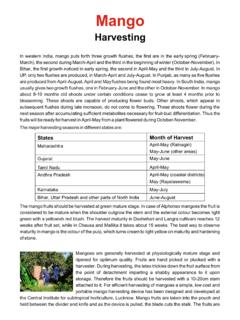Transcription of WORLD MANGO MARKET SUPPLY, DEMAND AND …
1 WORLD MANGO MARKET supply , DEMAND AND FORECAST March 2015 Table of Contents Executive Summary 3 1. MANGO VARIETIES 5 Kent 5 Keitt 6 Tommy Atkins 6 2. WORLD DEMAND FOR MANGO 7 North America 8 The United States 8 Europe 9 Potential markets for the commercialization of MANGO 10 Evolution of prices 11 3. WORLD MANGO supply 12 Mexico 13 India 14 Seasonality 15 MANGO with added value 15 Frozen MANGO 16 Preserved mangoes 17 Functional and energy drinks 17 MANGO pur e 17 MANGO pulp 18 4. FORECASTS AND CONCLUSIONS 18 Executive Summary MANGO is known the WORLD over as a fruit with many nutritional qualities, as it is rich in minerals, fiber, vitamins and provitamins.
2 Also referred to as the peach of the tropics, this fruit is one of the main types of fruit considered exotic. Because it is sweet, refreshing and aromatic, it is commercialized throughout the WORLD . Around 160 varieties of mangoes are cultivated in more than 90 countries. The Keitt, Kent and Tommy Atkins varieties are the best known and in the greatest DEMAND by the major markets for this fruit. This is the case in the European Union and the United States, where consumption has been on the rise in recent years, making them the focus of MANGO commercialization worldwide. Apart from major Asian consumers, the main markets for the commercialization of mangoes are the Netherlands, with a per capita consumption of kilos; Canada, with a consumption of ; Portugal, with ; the United States, with ; the United Kingdom, with ; and Germany, with kilos per capita.
3 The United States is the WORLD s largest importer of mangoes, following the trend for the guava, MANGO and mangosteen fresh or dried category, where mangoes account for the largest percentage of products by far. With an average annual growth rate (AAGR) of , the United States accounts for approximately 30% of all MANGO imports. In addition, there are other important markets such as China, Vietnam, the United Arab Emirates, Saudi Arabia and Hong Kong that import substantial amounts as well. On the supply side, mangoes can now be found in South Asia, where they originated, as well as in the Americas, where Mexico, Brazil, Peru and Colombia are the largest producers. Taking into account the category to which mangoes pertain (guava, MANGO and mangosteen), global production of this fruit has grown in recent years.
4 In 2013, 43,300,000 tons were produced, which is 24% than the total for 2009. By far, Asian countries produce the largest volumes of mangoes worldwide. India is the WORLD s largest producer by a wide margin, with more than 40% of global production in 2013. India is followed by China, Thailand and Indonesia with production of , and 2 million tons respectively in that same year. With regard to exports, in 2013, Mexico accounted for 20% of WORLD MANGO exports, positioning it as the largest exporter of this fruit, with 338,169 tons shipped that year. Mexico is followed by India, Thailand and Peru. Due to their popularity, today mangoes are commercialized worldwide in different types of processed products. As they are highly versatile and sweet, mangoes can be used in countless products such as jams, jellies, ice cream, juices, and functional and energy drinks, or sold as canned fruit, pulp, frozen chunks, dried fruit, chunks in syrup, etc.
5 WORLD DEMAND for mangoes is on the rise and is expected to continue increasing, especially in markets such as the United States, Canada, the European Union, and even Asian markets including China. It is estimated that international trade in fresh mangoes will amount to approximately USD 1,799,000 million in 2029; that is, moderate but constant growth in worldwide trade in this fruit is forecasted. In addition, given the trend seen in the consumption of organic products in recent years in countries such as the United States and Germany, USD million in sales of organic mangoes are expected for 2029; that is, 15% more than the total for 2014.





